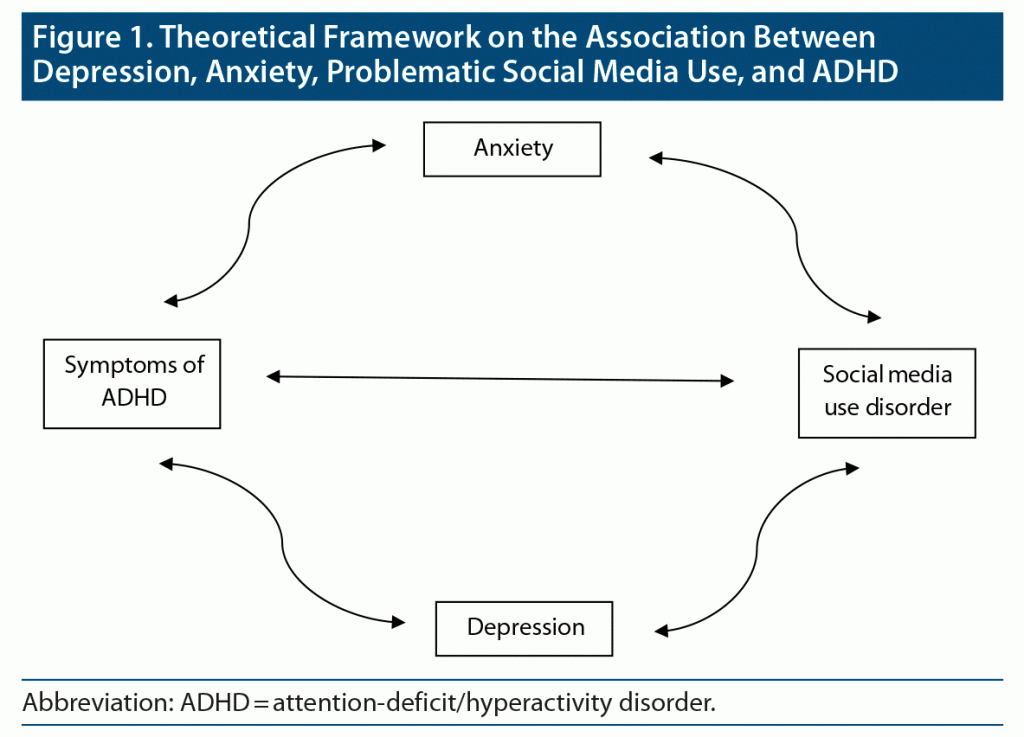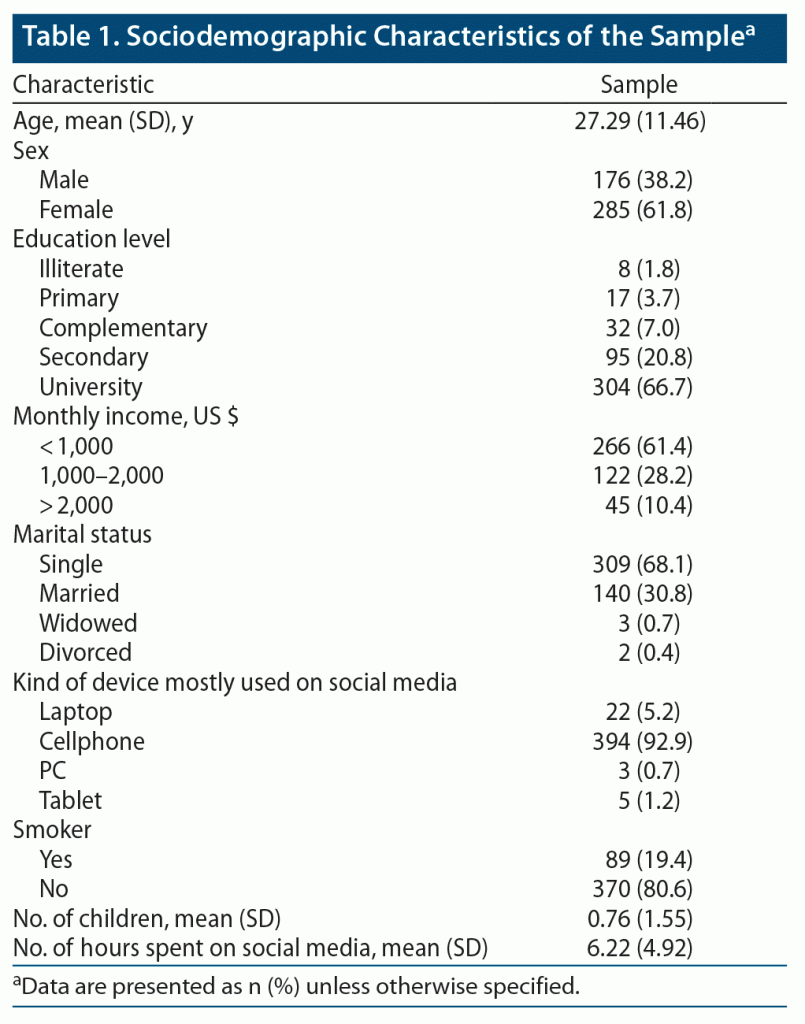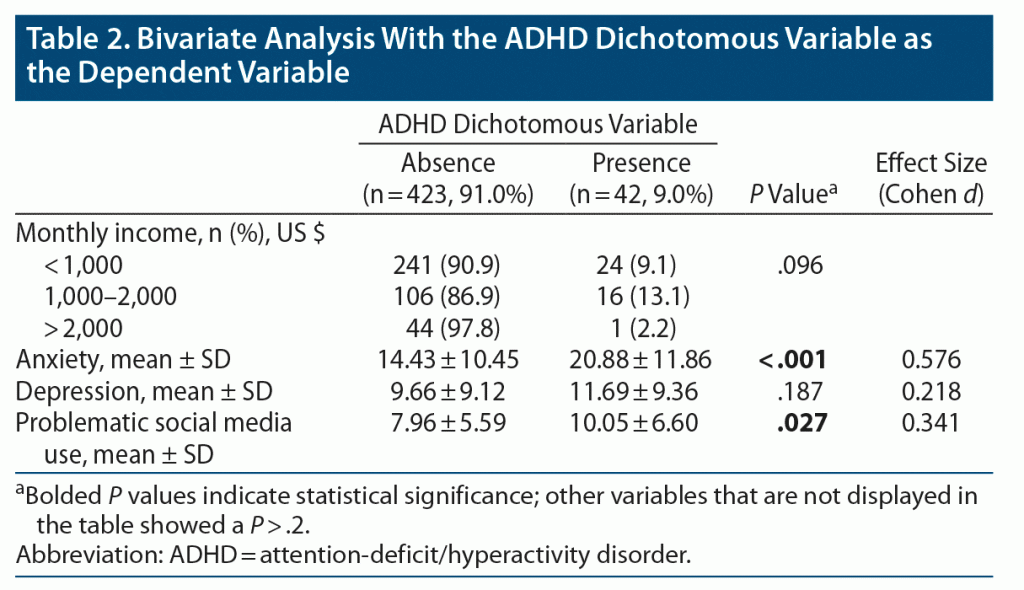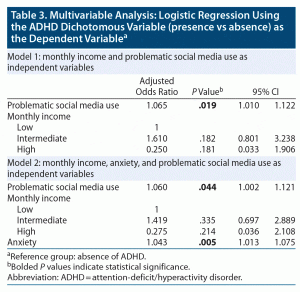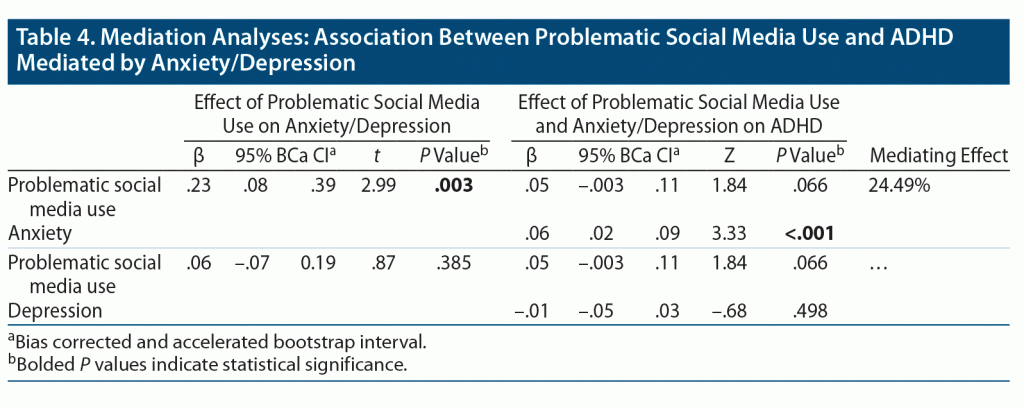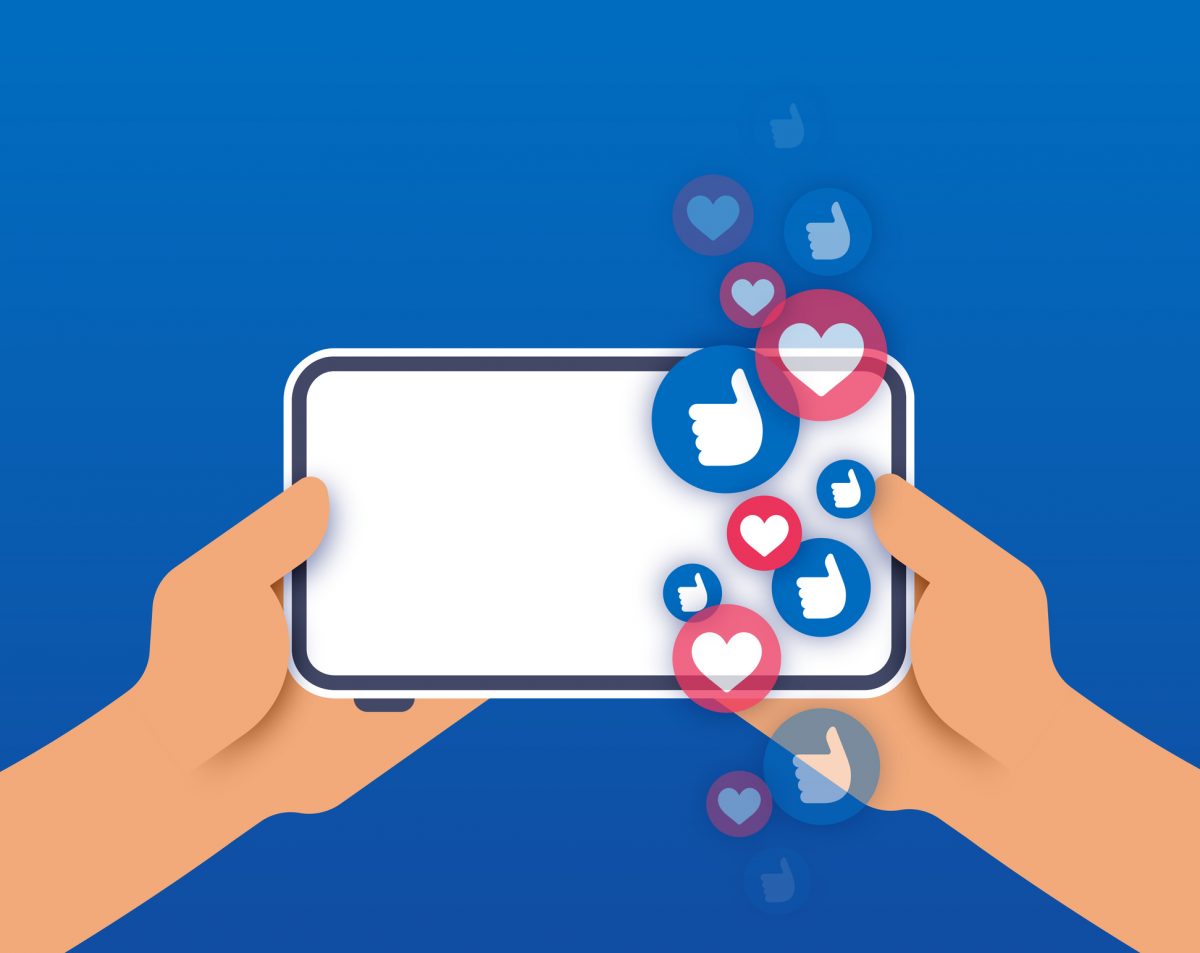ABSTRACT
Objective: Attention-deficit/hyperactivity disorder (ADHD) has been recognized as a clinically diverse condition with elevated rates of comorbidities with other psychiatric conditions. The consequences of social media are gaining attention worldwide due to its rapidly increased use. The objective of this study was to identify an association between problematic social media use and ADHD in a Lebanese sample and determine whether depression or anxiety could be considered as mediators of this association.
Methods: This cross-sectional study was conducted between January and May 2019. Proportionate random-sampling techniques were applied on all Lebanese governorates, which resulted in the recruitment of 466 community-dwelling participants. Adult ADHD was identified using the Adult ADHD Self-Report Scale.
Results: Higher problematic social media use (adjusted odds ratio [aOR] = 1.065) was significantly associated with higher odds of having ADHD. When anxiety was added as an independent variable, the results showed that higher anxiety (aOR = 1.043) was significantly associated with higher odds of ADHD. Anxiety mediated the association between problematic social media use and ADHD by 26.75%.
Conclusions: A clear correlation was demonstrated in this study linking problematic social media use to anxiety and ADHD symptoms. This correlation was explained by the finding that constant stimulation provided by the social network sites significantly decreased attention. Future studies should evaluate the possible mechanisms and methods to increase awareness of problematic social media use, especially among the younger generation.
Prim Care Companion CNS Disord 2022;24(2):21m03025
To cite: Farchakh Y, Dagher M, Barbar S, et al. Association between problematic social media use and attention-deficit/hyperactivity disorder in a sample of Lebanese adults. Prim Care Companion CNS Disord. 2022;24(2):21m03025.
To share: https://doi.org/10.4088/PCC.21m03025
© Copyright 2022 Physicians Postgraduate Press, Inc.
aSchool of Medicine and Medical Sciences, Holy Spirit University of Kaslik, Jounieh, Lebanon
bResearch Department, Psychiatric Hospital of the Cross, Jal Eddib, Lebanon
cUniv. Limoges, UMR 1094, Neuroépidémiologie Tropicale, Institut d’Epidémiologie et de Neurologie Tropicale, GEIST, Limoges, France
dINSPECT-LB: Institut National de Sante Publique, Epidemiologie Clinique et Toxicologie, Beirut, Lebanon
eSchool of Pharmacy, Lebanese International University, Beirut, Lebanon
‡Drs Farchakh and Dagher are first co-authors; Drs Hallit and Obeid are last co-authors
*Corresponding author: Souheil Hallit, PharmD, MSc, MPH, PhD, School of Medicine and Medical Sciences, Holy Spirit University of Kaslik (USEK), PO Box 446, Jounieh, Lebanon ([email protected]).
Attention-deficit/hyperactivity disorder (ADHD) is defined as “a behavioral condition that makes focusing on everyday requests and tasks challenging.”1 ADHD has long been a topic of interest when studying human nature and conduct. It is characterized by a persistent mode of inattention, hyperactivity, and/or impulsivity, typically leading to trouble staying focused, getting organized, making rational plans, and thinking before acting.1 Epidemiologic research has shown an estimated prevalence of ADHD varying between 5% and 10%.2 Given that many adults and children are affected by this public health problem, a great deal of research has investigated the associated factors related to ADHD, as well as the effects on mental and emotional health. Indeed, it has been shown that patients with ADHD report psychological and social difficulties greatly affecting their quality of life.3–5 Additionally, previous research found that more than half of individuals with ADHD also had another mental disorder,6 drawing attention to the need for further investigations concerning ADHD correlates and comorbidities.
In recent years, social media use has markedly increased, reaching over 2 billion users worldwide.7,8 According to a study8,9 conducted in 2018, 45% of adolescents and young adults admitted to being constantly online. Despite the benefits of technology, such as fast access to information, easy connection with communities worldwide, and entertainment and business development, increasing use of social network sites can lead to the potential risk of addiction known as “problematic social media use.” The influence of pathologic social media use on attention remains a central topic of investigation. Research suggests that ADHD is common among young people dealing with uncontrolled internet and problematic social media use, which raises the concern that interactivity and reflexive reactivity on mobile media may have a role to play in the cultivation of ADHD symptoms among adolescents.10
Depression and anxiety are common disorders in primary care with high chances of coexistence. According to the World Health Organization (WHO), the mental hardship due to depression and other mental health conditions is escalating on a global scale.11 Decades of research have investigated the impact of depression on ADHD, which has revealed biases and in a few cases impairments. In samples of adults with ADHD, Knouse et al12 noted an estimated percentage of major depressive disorder ranging from 16% to 31%. In addition, individuals with anxiety frequently suffer from attention disorder. Also, significant overlapping rates (close to 30%) of anxiety and ADHD in schoolchildren13 may suggest a relationship between the 2 disorders.
A 2-way relationship between all the variables could be hypothesized. First, it has been shown that individuals with ADHD who suffer from inattention and impulsivity are at increased risk of problematic social media use.14 Conversely, people who suffer from problematic social media use are at increased risk to develop symptoms of ADHD such as inattention. Second, the association between different mood disorders and ADHD also manifest such that one may lead to the other. Having ADHD was highly linked to the likelihood of developing depression and anxiety and vice versa.15 Finally, individuals with these psychiatric disorders, and in particular emotional disorders, are more prone to develop an addiction such as problematic social media use.16 Reciprocally, higher levels of problematic social media use were shown to be associated with more depressive and anxiety symptoms,17,18 alexithymia,19 loneliness,20 and lower memory performance.21 All these bidirectional relationships are elucidated in the theoretical framework presented in Figure 1 and suggest that depression or anxiety could mediate the association between problematic social media use and ADHD.
To summarize, ADHD is recognized as a clinically diverse condition with elevated rates of comorbidities with other psychiatric conditions.10 Furthermore, the consequences of social media are gaining much attention worldwide because of its rapidly increased use,8 which underscores the need for future studies. We found no studies on social media use and ADHD in the literature, which made the pursuit of this topic more compelling. Moreover, a recent article22 in Lebanon revealed a prevalence of 25% of adolescents that suffer from 1 psychiatric disorder, most commonly anxiety disorders and ADHD. It also highlighted that this prevalence in Lebanon is much higher than in other Arab countries.22 For that reason and considering the harmful consequences of psychiatric diseases such as higher risk of developing substance abuse23,24 and lower socioeconomic status,25 it was of importance to highlight different aspects of the relationship between ADHD and social media as well as different mood disorders. The objective of this study was to identify an association between problematic social media use and ADHD in a Lebanese sample and determine whether depression or anxiety could be considered as mediators of this association.
METHODS
Study Design and Participants
This cross-sectional study was conducted between January and May 2019; 466 randomly selected citizens were enrolled from Lebanon’s governorates (mohafazat) in a proportionate rate. The governorates are split into districts (caza), which in turn are subdivided into villages. Two villages from each district were selected from a list presented by the Central Agency of Statistics in Lebanon. Households of the villages were randomly assigned the questionnaire based on a random-sampling technique. Study-independent pharmacy students conducted face-to-face interviews with participants. All individuals aged > 18 years were considered eligible to participate in the study. Subjects who did not complete the questionnaire by the deadline and those with dementia (reported by a family member) were not included in the study. The study-independent pharmacy students underwent training to complete the data collection process. The methodology implemented in this research project is the same as that applied in earlier articles.17–20
Minimal Sample Size Calculation
According to the G-power software and based on an effect size of f2 = 4%, an α error of 5%, a power of 80%, and taking into consideration 11 factors to be entered in the multivariable analysis, the results showed that a minimal number of 416 participants was needed.
Questionnaire
Arabic, the native language of Lebanon, was the language of choice when administering the questionnaire. The participants’ sociodemographic characteristics (age, sex, education level, marital status, number of kids, and monthly income) were recorded at the beginning of the questionnaire. Monthly income (US $) was categorized as low (< 1,000), intermediate (1,000–2,000), and high (> 2,000). Measurement tools used in the study were included in the second part of the questionnaire.
Measurement Tools
Adult ADHD Self-Report Scale. The Adult ADHD Self-Report Scale is primarily used to identify adult ADHD in primary care settings.26 Eighteen DSM-IV-TR criteria constitute the measurement instrument otherwise known as the symptom checklist. Symptoms consistent with ADHD were best evaluated by 6 of the 18 questions.27 These 6 questions compose part A of the Symptom Checklist and are considered the basis for the Adult ADHD Self-Report Scale. The remaining 12 questions constitute part B of the symptom checklist. Answers are rated according to a 5-point Likert scale to evaluate ADHD symptomatology, with 0 signifying “never,” 1 “rarely,” 2 “sometimes,” 3 “often,” and 4 “very often.” That being said, “sometimes,” “often,” and “very often” occasionally imply clinical disability based on the item in question.27 The patient is considered to have symptoms highly compatible with ADHD in adults if 4 or more marks appear in the darkly shaded boxes within part A. The Cronbach α for this scale was very good (0.870). This variable was subsequently used as a dichotomous variable in the analysis.
Social Media Disorder Scale
The degree of problematic social media use was measured with the Social Media Disorder Scale,28 which is a 27-item scale in which higher scores reflect higher problematic social media use. The Cronbach α for this scale was very good (0.847).
Hamilton Depression Rating Scale
The validated Arabic version of the Hamilton Depression Rating Scale29,30 was used to identify depression. The severity of depressive symptoms is evaluated using the first 17 items of the scale.30 Adding the scores of these 17 items leads to the total depression score, with elevated scores signifying higher levels of depression. The Cronbach α achieved for this scale was good (0.873).
Hamilton Anxiety Rating Scale
The Hamilton Anxiety Rating Scale31 was recently validated in Lebanon.32 This scale is regularly used for medical and research purposes to measure anxiety. It encompasses 14 items, each graded on a 4-point Likert scale (with 0 signifying symptoms are not present and 4 signifying symptoms are very severe). Higher scores suggest higher levels of anxiety. The Cronbach α for this scale was good (0.914). It is important to mention that raw scale scores were used for all scales during the analysis.
Translation Procedure of the Questionnaire
The social media disorder and ADHD scales went through both forward and backward translations. One clinical psychologist took on the responsibility of converting the scales from English to Arabic, and another worked on translating the scales from Arabic back to English. Any differences among the 2 versions (English and Arabic) were resolved by consensus with the primary investigator.
Statistical Analysis
Data analysis was conducted using SPSS software version 25. Reliability analysis was possible for all the scales using their Cronbach α values. Continuous variables were comparable in 2 groups using the student t test. Linear correlation between continuous variables was conducted following Pearson correlation. The means of 2 groups were examined for contrast by utilizing the student t test. While assigning the Adult ADHD Self-Report Scale as the dependent variable, a logistic regression was conducted. To dispose of as many potential confounding factors as possible, only factors that demonstrated a P < .2 in the bivariate analysis were deemed important factors to be included in the model. To assess the mediating effect of anxiety/depression between problematic social media use and ADHD, the PROCESS SPSS Macro version 3.4 model 4 was used. The first pathway determined the regression coefficient between problematic social media use and the mediator (anxiety/depression), whereas the second pathway determined the regression coefficient between problematic social media use and anxiety/depression on ADHD. For variables to be considered significant, they needed to attain a P < .05.
RESULTS
Table 1 provides the sociodemographic details of the participants. The findings demonstrate that the participants’ mean ± SD age was 27.29 ± 11.46 years, and the average number of hours devoted to social media was 6.22 ± 4.92. Most of the subjects were female (61.8%), single (68.1%), had completed university-level education (66.7%), and had a low monthly income (61.4%). Most of the participants used their cellphone as the main device to access social media (92.9%), and 19.4% were smokers. The mean ± SD score of the Social Media Disorder Scale was 8.15 ± 5.71.
Bivariate Analysis
Bivariate analysis, considering the ADHD scale as the dependent variable, found substantially elevated mean anxiety and problematic social media use in participants with ADHD compared to those without ADHD (Table 2).
Multivariable Analysis
A backward logistic regression, taking the presence/absence of ADHD as the dependent variable and monthly income and problematic social media use as independent variables, showed that higher problematic social media use (adjusted odds ratio [aOR] = 1.065) was significantly associated with higher odds of ADHD (Table 3, model 1).
When anxiety was added as an independent variable, the results showed that higher anxiety (aOR = 1.043) was significantly associated with higher odds of ADHD (Table 3, model 2).
Mediation Analyses
Anxiety mediated the association between problematic social media use and ADHD by 24.49% (Table 4). Depression did not mediate this association.
DISCUSSION
This is the first study conducted among the Lebanese population evaluating the relationship between problematic social media use and ADHD after adjustment for various mood disorders such as anxiety and depression known to be related to ADHD. The results of this study clearly show that higher problematic social media use and anxiety were correlated to ADHD and that anxiety partially mediated the association between problematic social media use and ADHD.
First, as hypothesized, our results demonstrated that ADHD was positively correlated with problematic social media use, which agrees with previous studies.7–9,33 The primary symptom of ADHD is inattention, described as being easily distracted. While inattention often is a primary symptom, this may vary depending on the type of ADHD, age, and other considerations. For example, frequent beeping or vibrating phones, continuous updates from different types of applications, and thousands of people interacting on social media may drive these vulnerable individuals to use social network sites excessively and compulsively.7 Additionally, internet addiction might be considered a risk factor for developing ADHD, given that these constant diversions could disrupt the normal maturation of sustained attention and organization skills. Moreover, this type of platform also provides direct and fast access to highly stimulating experiences such as music, videos, movies, and all other types of interactions with rapid feedback in response to user input. Consequently, when users get used to this rapid feedback, a disruption of impulse control and loss of patience might result, leading to symptoms of ADHD.9
Second, the multivariable analysis established that higher anxiety was substantially correlated with the presence of ADHD compared to non-ADHD subjects and anxiety partially mediated the association between problematic social media use and ADHD. These findings are consistent with previous literature.34–37 A study37 reported that 16% of ADHD patients had comorbid anxiety. Studies38,39 have also shown a higher prevalence of anxiety disorders in patients with ADHD. This association was explained in multiple ways. First, both anxiety and ADHD display some extent of overlap in the symptom criteria, including problems with attention and concentration and restlessness.40 Second, Schatz and Rostain41 proposed that the lack of early cognitive regulation among individuals with ADHD may proceed to a failure to follow social standards and difficulties with peer relationships, leading to emotional dysregulation, which describes anxiety. Third, a study showed that the strong correlation between ADHD and anxiety might be elucidated by the similar brain structure pathologies that identify the 2 disorders. Levy42 advocated that impairment of the nucleus accumbens, which is one of the critical dopamine systems, would cause dysfunction in the mesolimbic and mesocortical circuits, which might be related to abnormal control of anxiety and attention deficits, respectively. We found that problematic social media use was highly linked to ADHD and that anxiety mediated this association. No study, to the best of our knowledge, has investigated the role of anxiety in the connection between problematic social media use and ADHD. Since problematic social media use is associated with some psychological and maladaptive variables such as lower self-confidence, decline in social circle size, low family function, and poor mental health,43 it may enhance anxiety symptoms, leading to ADHD symptoms. Finally, evidence supporting anxiety as a mediator of the relationship between problematic social media use and ADHD is still lacking; therefore, more research is needed.
Depression was not correlated to ADHD in our study, which is in contrast to previous studies.44–46 Individuals with ADHD have been linked to not only higher risk of depression but also more severe symptoms with a greater duration, combined with more psychiatric hospitalization and increased risk of suicidality compared to controls.47 The mechanism was possibly explained by difficulties with emotional regulation.44 Our questionnaire included self-report scales for recognition of ADHD and depressive symptoms. Since they were not conducted through an interview by a psychiatrist or a psychologist, these mood disorders might have been underdiagnosed. More studies considering these limitations should be conducted.
Clinical Implications
If a correlation can be made from this study in Lebanon, it would be that awareness of problematic social media use should be disseminated among parents and children to reduce its use and prioritize actions that encourage teenagers’ executive functioning and well-being such as sleep, physical activity, and positive interactions with family and friends. In addition, this study can open the gate for future investigations that prioritize prevention plans and possible interventions to mitigate the potential harmful effects of problematic social media use. It is also beneficial for researchers and clinicians to identify symptoms of psychiatric disorders, especially symptoms of ADHD, during intervention programs and consultations. In addition, if a subject has already been diagnosed with ADHD, it would be of great importance to look for signs and symptoms of other comorbid mood disorders such as depression and anxiety so that they can be identified and treated in their early stages to prevent further damage.
Specifically, mental health professionals should have knowledge of (1) symptoms of ADHD, (2) psychological and social difficulties affecting the quality of life of patients with ADHD, and (3) the association between ADHD and mental health (such as depression, anxiety, stress, insomnia, and problematic social media use). Then, health care professionals need to apply this understanding to their health promotion activities by (1) assessing ADHD and associated mental illness using the appropriate scales, (2) providing individual support (using counseling and cognitive‐behavioral techniques, implementing a mindfulness program), and (3) providing support to the family.
Limitations
This study adopted a cross-sectional design; therefore, it cannot evaluate the causality behind said interactions. All variables were evaluated through a self-report questionnaire and not through a clinical interview; thus, the answers might lack precision and exactitude. Because of the retrospective nature of our study, recall bias is a possibility. A selection bias can also be considered due to the participation refusal rate. Likewise, information bias may be present due to difficulties in understanding the question, recall deficiency, and over or under assessment of symptoms. In addition, males were numerically less represented than females, thus showcasing the necessity of designing future research projects that enroll similar numbers of males and females so that they are equally represented. Finally, concerning the ADHD questionnaire, the subclinical ADHD symptom score was not used and thus some individuals with subclinical symptoms might not have been detected, which possibly influenced our findings. Moreover, the correlation could possibly originate from shared risk factors. For instance, certain genetic or environmental components may equally enhance the development of ADHD symptoms and problematic social media use such as parents diagnosed with ADHD and substance use problems, which were not determined in this study. Finally, the results cannot be applied across the whole population given that the mean age of the sample was somewhat low and not representative of all age groups.
CONCLUSION
A clear correlation was demonstrated in this study between problematic social media use and ADHD symptoms. This correlation was explained by the finding that constant stimulation provided by the social network sites significantly decreased attention. Future studies should evaluate the possible mechanisms and methods for effective awareness, especially involving the younger generation. Therefore, it is necessary to highlight the importance of diagnosing and treating anxiety and depression, the incidence of which has increased over the past few decades.
Submitted: May 26, 2021; accepted August 13, 2021.
Published online: February 24, 2022.
Author contributions: Drs Obeid and Hallit conceived and designed the survey. Dr Dagher performed the data collection. Drs Haddad and Hallit were involved in the statistical analysis and data interpretation. Drs Dagher and Farchakh wrote the manuscript. All authors read the manuscript, critically revised it for intellectual content, and approved the final version.
Potential conflicts of interest: None.
Funding/support: None.
Additional information: The Psychiatric Hospital of the Cross Ethics and Research Committee approved this study protocol in compliance with the Hospital’s Regulatory Research Protocol (HPC-004-2019). A written consent was obtained from each participant. The authors do not have the right to share any data information as per their institutions policies.
Acknowledgments: The authors thank all the participants who helped during the project and Dina Dagher, MD (Faculty of Medicine and Medical Sciences, Holy Spirit University of Kaslik [USEK], Jounieh, Lebanon) for help with data entry. Dr Dagher reports no conflicts of interest related to the subject of this article.
Clinical Points
- Higher problematic social media use was significantly associated with higher odds of ADHD.
- Constant stimulation provided by the social network sites significantly decreased attention.
- Anxiety mediated the association between problematic social media use and ADHD.
References (47)

- American Psychological Association. ADHD. APA website. Accessed January 13, 2022. https://www.apa.org/topics/adhd/
- Thomas R, Sanders S, Doust J, et al. Prevalence of attention-deficit/hyperactivity disorder: a systematic review and meta-analysis. Pediatrics. 2015;135(4):e994–e1001. PubMed CrossRef
- Watters C, Adamis D, McNicholas F, et al. The impact of attention-deficit.hyperactivity disorder (ADHD) in adulthood: a qualitative study. Ir J Psychol Med. 2018;35(3):173–179. PubMed CrossRef
- Lee YC, Yang HJ, Chen VC, et al. Meta-analysis of quality of life in children and adolescents with ADHD: by both parent proxy-report and child self-report using PedsQL. Res Dev Disabil. 2016;51-52:160–172. PubMed CrossRef
- Peasgood T, Bhardwaj A, Biggs K, et al. The impact of ADHD on the health and well-being of ADHD children and their siblings. Eur Child Adolesc Psychiatry. 2016;25(11):1217–1231. PubMed CrossRef
- Cuffe SP, Visser SN, Holbrook JR, et al. ADHD and psychiatric comorbidity: functional outcomes in a school-based sample of children. J Atten Disord. 2020;24(9):1345–1354. PubMed CrossRef
- Statista. Number of Social Media Users Worldwide From 2010 to 2021 (in billions). Statista website. Accessed January 13, 2022. https://www.statista.com/statistics/278414/number-of-worldwide-social-network-users/
- Hussain Z, Griffiths MD. Problematic social networking site use and comorbid psychiatric disorders: a systematic review of recent large-scale studies. Front Psychiatry. 2018;9:686. PubMed CrossRef
- Pew Research Center. Teens, Social Media, and Technology 2018. Pew Research Center website. Accessed January 13, 2022. https://www.pewresearch.org/internet/2018/05/31/teens-social-media-technology-2018/
- Pluhar E, Kavanaugh JR, Levinson JA, et al. Problematic interactive media use in teens: comorbidities, assessment, and treatment. Psychol Res Behav Manag. 2019;12:447–455. PubMed CrossRef
- World Health Organization. Depression. WHO website. Accessed January 13, 2022. https://www.who.int/news-room/fact-sheets/detail/depression. 2020.
- Knouse LE, Zvorsky I, Safren SA. Depression in adults with attention-deficit/hyperactivity disorder (ADHD): the mediating role of cognitive-behavioral factors. Cognit Ther Res. 2013;37(6):1220–1232. PubMed CrossRef
- Overgaard KR, Aase H, Torgersen S, et al. Co-occurrence of ADHD and anxiety in preschool children. J Atten Disord. 2016;20(7):573–580. PubMed CrossRef
- Weissenberger S, Ptacek R, Klicperova-Baker M, et al. ADHD, lifestyles and comorbidities: a call for an holistic perspective - from medical to societal intervening factors. Front Psychol. 2017;8:454. PubMed CrossRef
- Turgay A, Ansari R. Major depression with ADHD: in children and adolescents. Psychiatry (Edgmont). 2006;3(4):20–32. PubMed
- Seabrook EM, Kern ML, Rickard NS. Social networking sites, depression, and anxiety: a systematic review. JMIR Ment Health. 2016;3(4):e50. PubMed CrossRef
- Malaeb D, Salameh P, Barbar S, et al. Problematic social media use and mental health (depression, anxiety, and insomnia) among Lebanese adults: any mediating effect of stress? Perspect Psychiatr Care. 2021;57(2):539–549. PubMed CrossRef
- Barbar S, Haddad C, Sacre H, et al. Factors associated with problematic social media use among a sample of Lebanese adults: the mediating role of emotional intelligence. Perspect Psychiatr Care. 2021;57(3):1313–1322. PubMed CrossRef
- Youssef L, Hallit R, Akel M, et al. Social media use disorder and alexithymia: any association between the two? results of a cross-sectional study among Lebanese adults. Perspect Psychiatr Care. 2021;57(1):20–26. PubMed CrossRef
- Youssef L, Hallit R, Kheir N, et al. Social media use disorder and loneliness: any association between the two? results of a cross-sectional study among Lebanese adults. BMC Psychol. 2020;8(1):56. PubMed CrossRef
- Dagher M, Farchakh Y, Barbar S, et al. Association between problematic social media use and memory performance in a sample of Lebanese adults: the mediating effect of anxiety, depression, stress and insomnia. Head Face Med. 2021;17(1):6. PubMed CrossRef
- Maalouf FT, Ghandour LA, Halabi F, et al. Psychiatric disorders among adolescents from Lebanon: prevalence, correlates, and treatment gap. Soc Psychiatry Psychiatr Epidemiol. 2016;51(8):1105–1116. PubMed CrossRef
- Egan TE, Dawson AE, Wymbs BT. Substance use in undergraduate students with histories of attention-deficit/hyperactivity disorder (ADHD): the role of impulsivity. Subst Use Misuse. 2017;52(10):1375–1386. PubMed CrossRef
- Banaschewski T, Coghill D, Zuddas A. Oxford Textbook of Attention Deficit Hyperactivity Disorder. Oxford University Press; 2018.
- Russell AE, Ford T, Williams R, et al. The association between socioeconomic disadvantage and attention deficit/hyperactivity disorder (ADHD): a systematic review. Child Psychiatry Hum Dev. 2016;47(3):440–458. PubMed CrossRef
- Faraone SV, Spencer TJ, Montano CB, et al. Attention-deficit/hyperactivity disorder in adults: a survey of current practice in psychiatry and primary care. Arch Intern Med. 2004;164(11):1221–1226. PubMed CrossRef
- Daigre Blanco C, Ramos-Quiroga JA, Valero S, et al; El ASRS C. Adult ADHD Self-Report Scale. Adult ADHD Self-Report Scale (ASRS-v1.1) symptom checklist in patients with substance use disorders. Actas Esp Psiquiatr. 2009;37(6):299–305. PubMed
- van den Eijnden RJ, Lemmens JS, Valkenburg PM. The Social Media Disorder Scale. Comput Human Behav. 2016;61:478–487. CrossRef
- Obeid S, Abi Elias Hallit C, Haddad C, et al. Validation of the Hamilton Depression Rating Scale (HDRS) and sociodemographic factors associated with Lebanese depressed patients. Encephale. 2018;44(5):397–402. PubMed CrossRef
- Hamilton M. A rating scale for depression. J Neurol Neurosurg Psychiatry. 1960;23(1):56–62. PubMed CrossRef
- Hamilton M. The assessment of anxiety states by rating. Br J Med Psychol. 1959;32(1):50–55. PubMed CrossRef
- Hallit S, Haddad C, Hallit R, et al. Validation of the Hamilton Anxiety Rating Scale and State Trait Anxiety Inventory A and B in Arabic among the Lebanese population. Clin Epidemiol Glob Health. 2020;7(3):1104–1109. CrossRef
- Radesky J. Digital media and symptoms of attention-deficit/hyperactivity disorder in adolescents. JAMA. 2018;320(3):237–239. PubMed CrossRef
- Hussain Z, Griffiths MD. The associations between problematic social networking site use and sleep quality, attention-deficit hyperactivity disorder, depression, anxiety and stress. Int J Ment Health Addict. 2021;19:686–700. CrossRef
- Koyuncu A, Çelebi F, Ertekin E, et al. Clinical effects of ADHD subtypes in patients with social anxiety disorder. J Atten Disord. 2019;23(12):1464–1469. PubMed CrossRef
- Souza I, Pinheiro MA, Mattos P. Anxiety disorders in an attention-deficit/hyperactivity disorder clinical sample. Arq Neuropsiquiatr. 2005;63(2B):407–409. PubMed CrossRef
- Melegari MG, Bruni O, Sacco R, et al. Comorbidity of attention-deficit/hyperactivity disorder and generalized anxiety disorder in children and adolescents. Psychiatry Res. 2018;270:780–785. PubMed CrossRef
- Anderson JC, Williams S, McGee R, et al. DSM-III disorders in preadolescent children: prevalence in a large sample from the general population. Arch Gen Psychiatry. 1987;44(1):69–76. PubMed CrossRef
- Bird HR, Canino G, Rubio-Stipec M, et al. Estimates of the prevalence of childhood maladjustment in a community survey in Puerto Rico. The use of combined measures. Arch Gen Psychiatry. 1988;45(12):1120–1126. PubMed CrossRef
- American Psychiatric Association. Diagnostic and Statistical Manual of Mental Disorders (DSM-5). Washington, DC: American Psychiatric Publishing; 2013.
- Schatz DB, Rostain AL. ADHD with comorbid anxiety: a review of the current literature. J Atten Disord. 2006;10(2):141–149. PubMed CrossRef
- Levy F. Synaptic gating and ADHD: a biological theory of comorbidity of ADHD and anxiety. Neuropsychopharmacology. 2004;29(9):1589–1596. PubMed CrossRef
- Akin A, Iskender M. Internet addiction and depression, anxiety and stress. Int Online J Educ Sci. 2011;3(1):138–148.
- Seymour KE, Chronis-Tuscano A, Halldorsdottir T, et al. Emotion regulation mediates the relationship between ADHD and depressive symptoms in youth. J Abnorm Child Psychol. 2012;40(4):595–606. PubMed CrossRef
- Xia W, Shen L, Zhang J. Comorbid anxiety and depression in school-aged children with attention deficit hyperactivity disorder (ADHD) and self-reported symptoms of ADHD, anxiety, and depression among parents of school-aged children with and without ADHD. Shanghai Jingshen Yixue. 2015;27(6):356–367. PubMed
- Panevska LS, Zafirova-Ivanovska B, Vasilevska K, et al. Relationship between ADHD and depression among university students in Macedonia. Mater Sociomed. 2015;27(1):18–21. PubMed CrossRef
- Biederman J, Ball SW, Monuteaux MC, et al. New insights into the comorbidity between ADHD and major depression in adolescent and young adult females. J Am Acad Child Adolesc Psychiatry. 2008;47(4):426–434. PubMed CrossRef
Please sign in or purchase this PDF for $40.
